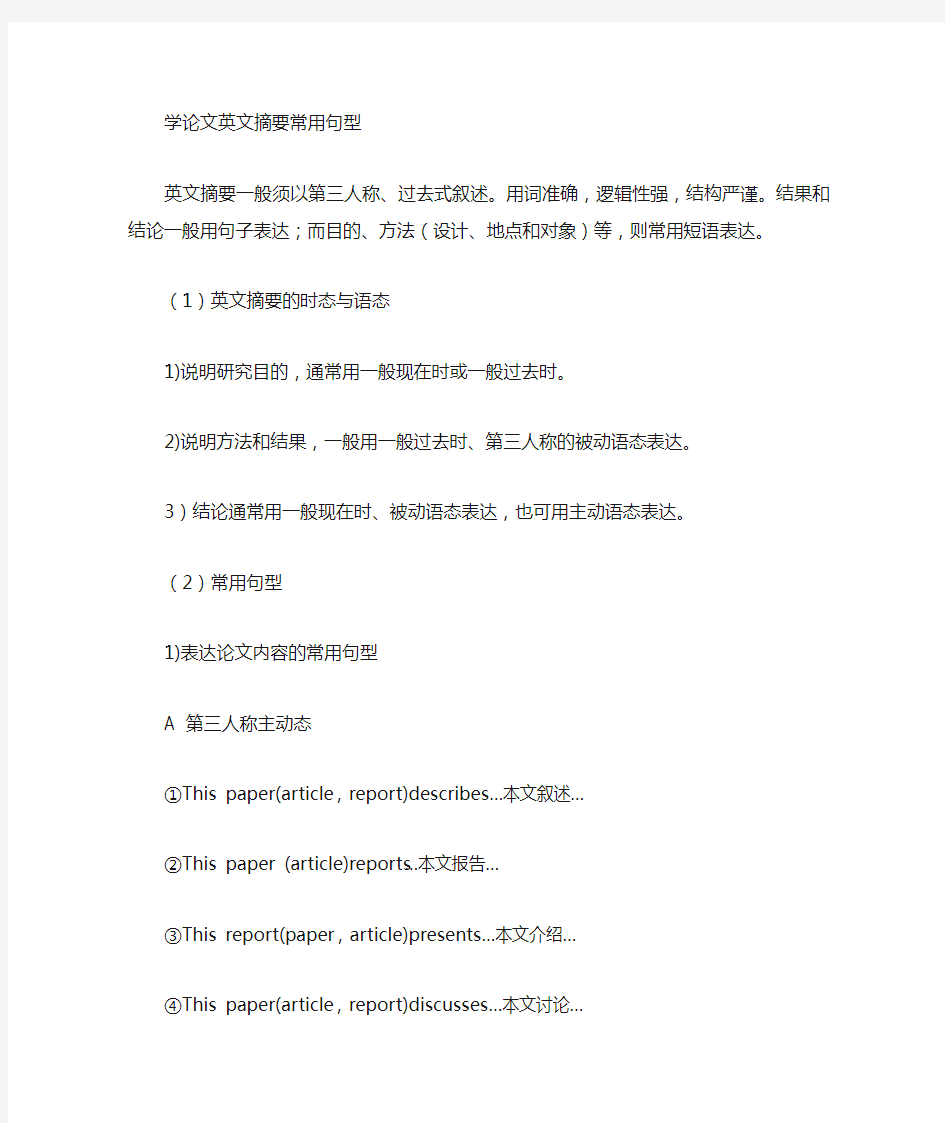
论文英文摘要常用句型
- 格式:doc
- 大小:36.50 KB
- 文档页数:4


学论文英文摘要常用句型
英文摘要一般须以第三人称、过去式叙述。用词准确,逻辑性强,结构严谨。结果和结论一般用句子表达;而目的、方法(设计、地点和对象)等,则常用短语表达。
(1)英文摘要的时态与语态
1)说明研究目的,通常用一般现在时或一般过去时。
2)说明方法和结果,一般用一般过去时、第三人称的被动语态表达。
3)结论通常用一般现在时、被动语态表达,也可用主动语态表达。
(2)常用句型
1)表达论文内容的常用句型
A 第三人称主动态
①This paper(article,report)describes…本文叙述…
②This paper (article)reports…本文报告…
③This report(paper,article)presents…本文介绍…
④This paper(article,report)discusses…本文讨论…
常用的动词还有analyze(分析),evaluate(评价),compare(比较),describe(描述)等。
B 第一人称主动态
⑤We report(on)…我们报告…
⑥We describe a case of…我们描述1例…
⑦In this paper,we present…本文介绍…
⑧In this paper,we report…本文报告…
主语除we之外,还可用the authors(作者)等。
C 一般现在时被动语态
⑨A case is reported in which…本文报告1例…
⑩A study of…is reported本文报告…的研究
⑧…is(are)described.本文描述…
⑥In this paper.…is(are)presented.本文介绍…
2)表达目的常用句型
A 一般过去时、被动语态
①The purpose(aim,objective)of this study was to…本研究旨在…
②The goal(aim)of this investigation was to…本研究旨在…
③This study was designed to…本研究旨在…
④This study was undertaken to…本研究旨在…
⑤This prospective study was performed to…本前瞻性研究的目的是…
⑥A study to…was carried out(during) (在…期间)所作研究的目的是…
⑦An attempt has been made to…为了…而作试验
B 动词不定式短语
To evaluate,report,investigate,study,analyze…
C 一般过去时、主动语态
⑧We(the authors)conducted a study to…为了…我们进行了研究
⑨To determine…,we studied…为了确定…,我们研究了…
⑩In an attempt to…,in an effort to…或in order to…,we carried out a pilot study…为了…,我们进行了…的初步研究
表示目的的常用动词有:evaluate(评价),examine(检查,观察),determine(确定,查明),elucidate(阐明),explore(探索),test(测试),compare(比较),estimate(评估),assess(估价),
investigate(调查)等。
3)表达方法的常用句型
A 方法
表达研究类型Prospective, Retrospective, Cohort,Case-control,in vivo, in vitro
①Using…(technique),we studied…我们用…(技术)研究了…
②Using…,it was found that…(我们)用…发现了…
③…was(were)measured using…(我们)用…测定了…
④…was(were)analyzed (reviewed)by…(我们)用…分析(回顾)了…
⑤…was(were)treated with…(我们)用…治疗了…
⑥…measurements were made of…测定了…
常用的动词还有:study,measure,determine,investigate,isolate,demonstrate,examine,identify等。
B 分组(主语通常为patients,subjects,animals)
⑦…were randomly divided (grouped)into…groups …被随机分成…组
⑧…were separated into…groups based on…根据…,将…分成…组
⑨The groups were as follows:分组如下:
C 治疗或检查方法
⑩…was performed(used)in (on)…patients 我们对…患者施行(应用)了…
(patients) underwent…endoscopy (患者)进行了…内镜检查
Surgical procedures, assay(immunohistochemistry, molecular biology…) 手术方法,测试方法…
C 统计学方法
Statistical methods: Student’s t test, χ2 … was used for
4)表达结果的常用句型
A 一般句型
①The results showed (demonstrated)that…结果表明…
②It was found that…(我们)发现…
③It was observed that…(我们)观察到…
第②和③句也可改为第一人称:We found that…和We observed that…。
B 增加或减少
④…decreased by(40%)…降低(40%)…
⑤…(a 70%) reduction in…was observed …观察到…降低(70%)
⑥There was a(15%) elevation in……增高(15%)
⑦…resulted in (a marked) increase in……导致…(明显)增高
⑧…was lowered from…to……从…下降到…
表达增加或减少的常用动词还有rise,raise,decline,drop,fall,lower等。可用by表示是净增减的数或倍数,例如“…increase by 40%”,表示“增加40%”;而to表示增加或减少到某个具体数值。
C 相关与差别
⑨There was a significant linear correlation between…and……与…有显著的线性相关性
⑩…showed no strong correlation between…and……显示…与…无密切相关性
⑩…correlated positively with……与…呈正相关
⑥A negative correlation was found between…and…发现…与…呈负相关
⑩There was (were)(no)significant difference(s)or (No)significant difference(s)